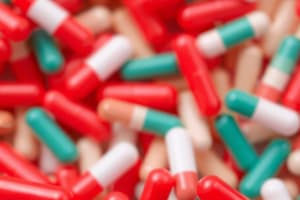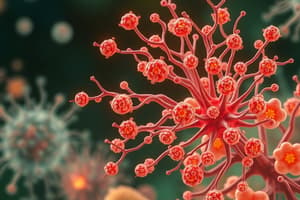Podcast
Questions and Answers
Which antimicrobial agent inhibits cell wall synthesis, primarily affecting bacteria?
Which antimicrobial agent inhibits cell wall synthesis, primarily affecting bacteria?
- Polymyxin B
- Rifampin
- Penicillin G (correct)
- Erythromycin
Which mechanism of action is associated with tetracycline's antimicrobial properties?
Which mechanism of action is associated with tetracycline's antimicrobial properties?
- Inhibition of DNA gyrase
- Inhibition of tRNA attachment during protein synthesis (correct)
- Inhibition of cell wall synthesis
- Interference with transcription
Which antimicrobial agent targets mRNA binding to the ribosome, inhibiting protein synthesis?
Which antimicrobial agent targets mRNA binding to the ribosome, inhibiting protein synthesis?
- Streptomycin
- Erythromycin (correct)
- Clindamycin
- Polymyxin B
Which antibiotic's mechanism of action involves changing the shape of the ribosome, thereby inhibiting protein synthesis?
Which antibiotic's mechanism of action involves changing the shape of the ribosome, thereby inhibiting protein synthesis?
Which antimicrobial disrupts the bacterial plasma membrane?
Which antimicrobial disrupts the bacterial plasma membrane?
Which antimicrobial specifically inhibits transcription?
Which antimicrobial specifically inhibits transcription?
Which antimicrobial inhibits DNA synthesis by targeting gyrase?
Which antimicrobial inhibits DNA synthesis by targeting gyrase?
Which antimicrobial affects bacteria by inhibiting the synthesis of mycolic acid?
Which antimicrobial affects bacteria by inhibiting the synthesis of mycolic acid?
Which antifungal agent disrupts sterol synthesis in the cell membrane?
Which antifungal agent disrupts sterol synthesis in the cell membrane?
Which antifungal agent inhibits glucan synthesis in the cell wall?
Which antifungal agent inhibits glucan synthesis in the cell wall?
Which antiviral agent is a nucleotide analog?
Which antiviral agent is a nucleotide analog?
Which antiviral combats influenza by inhibiting neuraminidase?
Which antiviral combats influenza by inhibiting neuraminidase?
Which of the following reflects the mechanism by which bacteria become resistant to antibiotics?
Which of the following reflects the mechanism by which bacteria become resistant to antibiotics?
Which of these drugs is known to be effective against tuberculosis (TB)?
Which of these drugs is known to be effective against tuberculosis (TB)?
Which drug is typically used to treat infections caused by fungi?
Which drug is typically used to treat infections caused by fungi?
Which drug is primarily used to treat protozoan infections?
Which drug is primarily used to treat protozoan infections?
Which medication is typically used to treat MRSA (Methicillin-resistant Staphylococcus aureus) infections?
Which medication is typically used to treat MRSA (Methicillin-resistant Staphylococcus aureus) infections?
Which antiviral accelerate mutation rate?
Which antiviral accelerate mutation rate?
Which of the following antibiotics are typically found in ointment form?
Which of the following antibiotics are typically found in ointment form?
Which antimicrobial agents primarily treat tuberculosis?
Which antimicrobial agents primarily treat tuberculosis?
Flashcards
Penicillin G, Methicillin, Amoxicillin, Ampicillin, Cephalosporin, Bacitracin, Vancomycin, Augmentin
Penicillin G, Methicillin, Amoxicillin, Ampicillin, Cephalosporin, Bacitracin, Vancomycin, Augmentin
Inhibit cell synthesis
Tetracycline
Tetracycline
Protein synthesis, inhibit tRNA attachment
Erythromycin
Erythromycin
Protein synthesis; inhibit mRNA binding to ribosome
Streptomycin, Neomycin
Streptomycin, Neomycin
Signup and view all the flashcards
Clindamycin
Clindamycin
Signup and view all the flashcards
Polymyxin B
Polymyxin B
Signup and view all the flashcards
Rifampin
Rifampin
Signup and view all the flashcards
Ciprofloxacin
Ciprofloxacin
Signup and view all the flashcards
TMP-SMZ (Bactrim)
TMP-SMZ (Bactrim)
Signup and view all the flashcards
Amphotericin B
Amphotericin B
Signup and view all the flashcards
Interferon
Interferon
Signup and view all the flashcards
Tamiflu, Relenza
Tamiflu, Relenza
Signup and view all the flashcards
Isoniazid, Ethambutol
Isoniazid, Ethambutol
Signup and view all the flashcards
Study Notes
- These notes cover antimicrobials, their mechanisms of action, and the microbes they affect
- Also covered are antibiotics, antivirals, and ways bacteria become resistant
Antimicrobials and Their Mechanisms
-
Penicillin G, Methicillin, Amoxicillin, Ampicillin, Cephalosporin, Bacitracin, Vancomycin, and Augmentin inhibit cell wall synthesis
- They are effective against bacteria
-
Tetracycline inhibits protein synthesis by preventing tRNA attachment
- It is effective against bacteria
-
Erythromycin inhibits protein synthesis by preventing mRNA binding to the ribosome
-
Streptomycin and Neomycin inhibit protein synthesis by changing the shape of the ribosome
-
Clindamycin inhibits protein synthesis by inhibiting peptide bond formation
-
Polymyxin B damages the plasma membrane of bacteria
-
Rifampin inhibits transcription, affecting Bacteria, specifically Tuberculosis (TB)
-
Ciprofloxacin inhibits DNA synthesis by targeting gyrase
- It is effective against bacteria
-
TMP-SMZ (Bactrim) inhibits bacterial metabolism
- It is effective against bacteria
-
Isoniazid and Ethambutol inhibit mycolic acid synthesis
- They treat TB and Leprosy
-
Amphotericin B disrupts sterol synthesis in the membrane of fungi
-
Fluconazole and Ketoconazole disrupt sterol synthesis in the membrane
-
Caspofungin inhibits glucan synthesis in the cell wall
-
Flucytosine interferes with transcription by acting as a cytosine analog
-
Chloroquine affects membrane function, targeting protozoans
-
Metronidazole deactivates enzymes
Antivirals
- Acyclovir is a nucleotide analog and targets viral infections
- Ribavirin accelerates the mutation rate
- It is effective as an antiviral
- Interferon inhibits viral replication
- Tamiflu and Relenza inhibit neuraminidase and are antivirals for the flu
Additional Information
- Bacitracin, polymyxin B, and neomycin are antibiotics found in ointments
- Vancomycin is an antibiotic used to treat MRSA (Methicillin-resistant Staphylococcus aureus)
- Rifampin, isoniazid, and ethambutol are drugs used to treat tuberculosis (TB)
Bacterial Resistance to Antibiotics
- Bacteria can develop resistance through mutations
- Bacteria can also gain resistance through conjugation and transduction
Studying That Suits You
Use AI to generate personalized quizzes and flashcards to suit your learning preferences.




